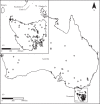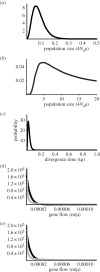Did postglacial sea-level changes initiate the evolutionary divergence of a Tasmanian endemic raptor from its mainland relative?
- PMID: 24174114
- PMCID: PMC3826236
- DOI: 10.1098/rspb.2013.2448
Did postglacial sea-level changes initiate the evolutionary divergence of a Tasmanian endemic raptor from its mainland relative?
Abstract
Populations on continental islands are often distinguishable from mainland conspecifics with respect to body size, appearance, behaviour or life history, and this is often congruent with genetic patterns. It is commonly assumed that such differences developed following the complete isolation of populations by sea-level rise following the Last Glacial Maximum (LGM). However, population divergence may predate the LGM, or marine dispersal and colonization of islands may have occurred more recently; in both cases, populations may have also diverged despite ongoing gene flow. Here, we test these alternative hypotheses for the divergence between wedge-tailed eagles from mainland Australia (Aquila audax audax) and the threatened Tasmanian subspecies (Aquila audax fleayi), based on variation at 20 microsatellite loci and mtDNA. Coalescent analyses indicate that population divergence appreciably postdates the severance of terrestrial habitat continuity and occurred without any subsequent gene flow. We infer a recent colonization of Tasmania by marine dispersal and cannot discount founder effects as the cause of differences in body size and life history. We call into question the general assumption of post-LGM marine transgression as the initiator of divergence of terrestrial lineages on continental islands and adjacent mainland, and highlight the range of alternative scenarios that should be considered.
Keywords: Last Glacial Maximum; inbreeding depression; marine dispersal; sea level; subspecies; vicariance.
Figures





Similar articles
-
Isolation, marine transgression and translocation of the bare-nosed wombat (Vombatus ursinus).Evol Appl. 2019 Mar 21;12(6):1114-1123. doi: 10.1111/eva.12785. eCollection 2019 Jun. Evol Appl. 2019. PMID: 31293627 Free PMC article.
-
Genetic evidence for a recent divergence and subsequent gene flow between Spanish and Eastern imperial eagles.BMC Evol Biol. 2007 Sep 24;7:170. doi: 10.1186/1471-2148-7-170. BMC Evol Biol. 2007. PMID: 17892545 Free PMC article.
-
Plio-Pleistocene sea level and temperature fluctuations in the northwestern Pacific promoted speciation in the globally-distributed flathead mullet Mugil cephalus.BMC Evol Biol. 2011 Mar 31;11:83. doi: 10.1186/1471-2148-11-83. BMC Evol Biol. 2011. PMID: 21450111 Free PMC article.
-
High Frequency of Lead Exposure in the Population of an Endangered Australian Top Predator, the Tasmanian Wedge-Tailed Eagle (Aquila audax fleayi).Environ Toxicol Chem. 2021 Jan;40(1):219-230. doi: 10.1002/etc.4914. Epub 2020 Dec 3. Environ Toxicol Chem. 2021. PMID: 33090553 Free PMC article.
-
Multilocus genetic diversity and historical biogeography of the endemic wall lizard from Ibiza and Formentera, Podarcis pityusensis (Squamata: Lacertidae).Mol Ecol. 2013 Oct;22(19):4829-41. doi: 10.1111/mec.12443. Epub 2013 Aug 21. Mol Ecol. 2013. PMID: 23962158
Cited by
-
Adaptive Genetic Divergence Despite Significant Isolation-by-Distance in Populations of Taiwan Cow-Tail Fir (Keteleeria davidiana var. formosana).Front Plant Sci. 2018 Feb 1;9:92. doi: 10.3389/fpls.2018.00092. eCollection 2018. Front Plant Sci. 2018. PMID: 29449860 Free PMC article.
-
Population demographic history of a temperate shrub, Rhododendron weyrichii (Ericaceae), on continental islands of Japan and South Korea.Ecol Evol. 2016 Nov 21;6(24):8800-8810. doi: 10.1002/ece3.2576. eCollection 2016 Dec. Ecol Evol. 2016. PMID: 28035270 Free PMC article.
-
Isolation, marine transgression and translocation of the bare-nosed wombat (Vombatus ursinus).Evol Appl. 2019 Mar 21;12(6):1114-1123. doi: 10.1111/eva.12785. eCollection 2019 Jun. Evol Appl. 2019. PMID: 31293627 Free PMC article.
References
-
- Keogh JS, Scott IAW, Hayes C. 2005. Rapid and repeated origin of insular gigantism and dwarfism in Australian tiger snakes. Evolution 59, 226–233 (doi:10.1554/04-310) - DOI - PubMed
-
- Clegg SM, Frentiu FD, Kikkawa J, Tavecchia G, Owens IPF. 2008. 4000 years of phenotypic change in an island bird: heterogeneity of selection over three microevolutionary timescales. Evolution 62, 2393–2410 (doi:10.1111/j.1558-5646.2008.00437.x) - DOI - PubMed
-
- Myers S, Brown G, Kleindorfer S. 2010. Divergence in New Holland Honeyeaters (Phylidonyris novaehollandiae): evidence from morphology and feeding behavior. J. Ornithol. 151, 287–296 (doi:10.1007/s10336-009-0454-7) - DOI
-
- Castilla AM, Herrel A, Gosa A. 2008. Mainland versus island differences in behaviour of Podarcis lizards confronted with dangerous prey: the scorpion Buthus occitanus. J. Nat. Hist. 42, 2331–2342 (doi:10.1080/00222930802254763) - DOI
-
- Schlotfeldt BE, Kleindorfer S. 2006. Adaptive divergence in the Superb Fairy-wren (Malurus cyaneus): a mainland versus island comparison of morphology and foraging behaviour. Emu 106, 309–319 (doi:10.1071/mu06004) - DOI
Publication types
MeSH terms
Substances
LinkOut - more resources
Full Text Sources
Other Literature Sources
Miscellaneous

